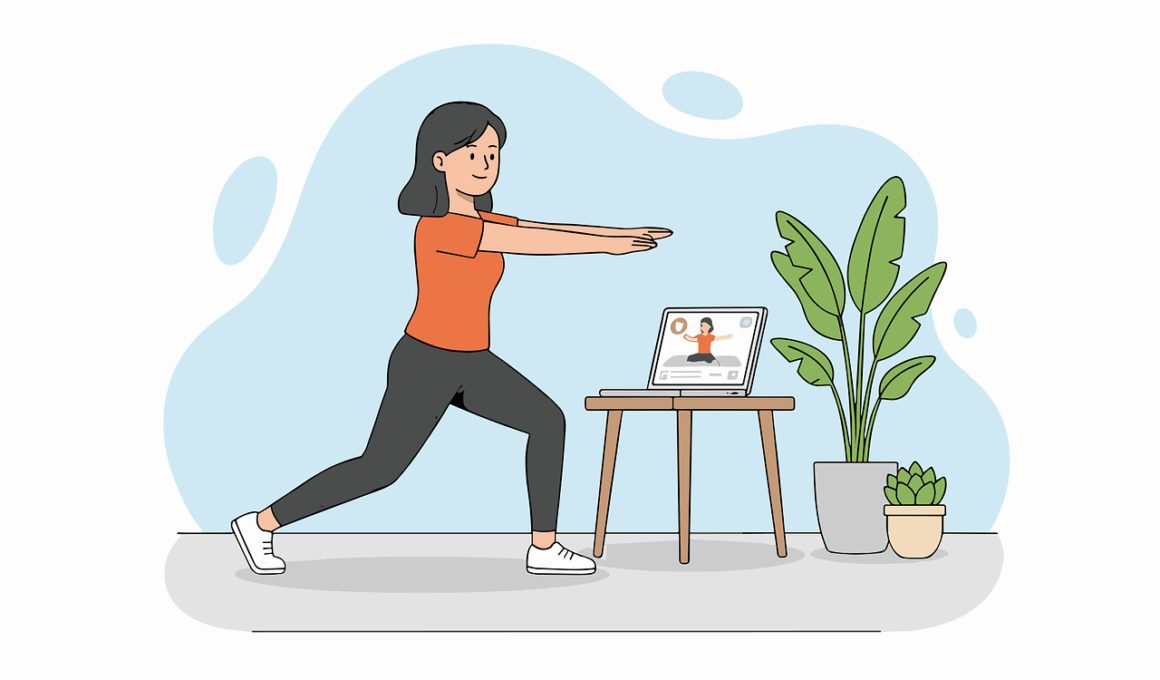Nutrition Tips to Support Your Home HIIT Workouts
To elevate your Home HIIT workouts, it’s essential to give your body the right fuel. The focus should be on a balanced diet rich in whole foods. Begin your day with a substantial meal, including complex carbohydrates such as oats or whole grains. They provide sustainable energy, necessary for high-intensity sessions. Protein intake is equally crucial, as it aids in muscle recovery and growth. Include sources like lean meats, legumes, or dairy. Hydration cannot be overlooked; drinking enough water supports energy levels and performance. Likewise, consider incorporating fruits and vegetables, which supply necessary vitamins and minerals. These nutrients bolster your immune system, enhancing your ability to continue training consistently. Timing can greatly impact your performance — aim to eat a balanced meal within the two hours before your workout. This will optimize energy levels during HIIT, where every second counts. Post-workout meals should combine protein and carbs; a smoothie with whey and banana makes a fantastic choice. Conclusively, awareness of your nutritional intake forms the foundation for effective HIIT workouts at home.
Your pre-workout nutrition plays a fundamental role in maximizing performance. To achieve optimal results in your HIIT routines, eating carbohydrates before training is beneficial. Carbs increase your glycogen stores, providing readily available energy during your workouts. Options like a banana, whole grain toast, or a small bowl of oatmeal can be efficient pre-workout choices. It is also advisable to combine these carbs with protein. This combination can help in reducing muscle breakdown and enhancing recovery. You may consider Greek yogurt with fruit as a great option for a pre-workout snack. Moreover, a small serving of nuts could also do wonders, thanks to the healthy fats and additional protein. For those sensitive to food intake before exercising, ensure you have your snack at least one hour prior to your HIIT session to avoid discomfort. After your workout, nutrition becomes pivotal for recovery. Consistently refueling your body with the right balance of protein and carbohydrates is crucial, ensuring your muscles recover and are ready for your next intense workout.
Essential Nutrients for HIIT Success
An effective HIIT regimen demands specific nutrients to keep your body functioning efficiently. Focus on incorporating adequate protein, essential for muscle repair and synthesis. Good sources include chicken, fish, eggs, and plant-based options like quinoa or beans. Omega-3 fatty acids also play a significant role in reducing inflammation, which can arise from challenging workouts. Foods rich in Omega-3, such as fatty fish, walnuts, or flaxseeds, should be part of your nutrition plan. Additionally, ensure you’re getting enough vitamins and minerals, particularly B vitamins, as they assist in energy production. Leafy greens, whole grains, and lean meats will help meet these requirements. Micronutrients can become depleted during intense exercise, so incorporate multivitamins as necessary. Furthermore, healthy fats contribute to prolonged energy; avocados, nuts, and olive oil can help sustain you between meals. Hydration is also critical; aim to drink water consistently, balancing electrolytes, especially after intense sweating. Remember that your nutrition directly correlates to performance and recovery; making these adjustments can significantly influence your Home HIIT workouts.
Carbohydrate cycling can be a beneficial strategy for those engaged in intense HIIT workouts. Adjusting carbohydrate intake based on workout intensity or volume optimizes performance and fat loss. On high-intensity training days, consume more carbohydrates to fuel your workouts. This provides energy for those demanding sessions, enabling you to push harder. Conversely, on rest or light workout days, reduce carbohydrate intake slightly. This helps the body utilize fat stores for energy, promoting weight loss while maintaining muscle. Pay attention to your body’s response to these dietary changes. Not everyone will respond the same way; tailoring it based on your personal experience is crucial. When intelligently applied, carbohydrate cycling aids in maintaining energy levels without unnecessary weight gain. Pair this strategy with a consistent hydration routine—proper water intake supports optimal physical performance. Additionally, recovery nutrition is key; post-workout, prioritize replenishing glycogen stores. This can come from high-carb snacks post-exercise, such as a smoothie or whole grain rice dishes. Ultimately, effective nutrition strategies significantly enhance your Home HIIT workout performance.
Mindfulness and Eating
Becoming mindful about your nutrition can dramatically influence your overall training success. Instead of having meals mindlessly, concentrate on what you eat. Practice mindful eating to improve your relationship with food. Pay attention to portion sizes, aiming for balance rather than deprivation. During meals, savor each bite and take time to chew thoroughly. This approach allows you to recognize your body’s hunger cues better, preventing overeating. Also, try planning your meals throughout the week, ensuring a mix of nutrients. Foods rich in fiber not only fill you up but also improve digestion. Engage in preparing your meals — this connection can strengthen your food choices and motivate you. Consider keeping a food journal to track your nutrition, logging how specific foods affect your workout performance and recovery. Doing this helps to tailor your diet plan specifically for your Home HIIT workouts. Incorporating supplements might also be necessary, particularly if dietary restrictions limit essential nutrients. Evaluate how you feel during workouts to guide your food practices effectively.
Incorporating superfoods into your diet is a powerful way to enhance workout nutrition. Superfoods are nutrient-rich, offering health benefits and supporting your exercise regimen. Foods like berries, chia seeds, and acai are excellent additions; they provide antioxidants that combat inflammation and oxidative stress. Greens such as kale and spinach are similarly packed with nutrients and can be easily included in smoothies or salads. Probiotics also benefit your gut health; consider adding yogurt or kefir to your diet. Healthy gut function assists nutrient absorption, enhancing overall performance and recovery. Additionally, don’t forget about your hydration strategy; infusing water with slices of lemon, cucumber, or mint not only boosts flavor but also adds vitamins. Whole food shakes and nutrient-dense bars can serve as convenient snacks to keep your energy levels up. Be sure to consume these superfoods pre- and post-workout for maximum efficiency. Lastly, consistently reassess your nutrient intake; adjusting based on your individual response makes your nutrition plan much more effective, aligning it with your Home HIIT workout goals.
Conclusion
Achieving optimal performance in Home HIIT workouts goes beyond just the physical aspect; your nutrition is key. Building a tailored nutrition plan not only fuels your body but also supports recovery, providing necessary nutrients for improvement. Stay aware of your eating habits, focusing on a balance of macronutrients: carbohydrates, proteins, and fats. These should come from whole food sources to ensure maximum nutrient intake. Hydration is equally vital; never underestimate the power of water. A great post-workout meal allows for muscle recovery, incorporating both protein and carbs for replenishment. Moreover, regular adjustment and reassessment of your dietary choices allows for optimization. Experiment with timing your meals around workouts, and observe how your body reacts. It’s essential to adapt based on personal response, making fitness a unique journey. Whether you’re just starting or advancing to more complex HIIT routines, remember that what you eat profoundly influences your success. By following these nutrition tips, you’ll not only enhance your Home HIIT performance but also maintain your overall health.
Through this journey of improving your Home HIIT workouts, the importance of nutrition can’t be emphasized enough. Understanding how to properly fuel your body increases efficiency and boosts overall results. Consider investing time in meal prep, which ensures that you always have healthy options ready when hunger strikes. Quality of food plays a tremendous role; don’t compromise on nutrition for convenience. Prioritize whole foods over processed snacks; they help you sustain energy over time. Lastly, continue learning about nutrition and how different foods affect your health and workouts. Consulting a registered dietitian can provide customized guidance, tailored specifically to your body’s needs. Each individual has distinct requirements based on metabolism, workout intensity, and personal goals, making personalized advice invaluable. To conclude, consistent dietary choices play a crucial role in achieving long-term fitness goals. The connections between what you consume and your performance are strong. Following these nutrition tips will undoubtedly support your Home HIIT workouts and lead to better results, both physically and mentally.


